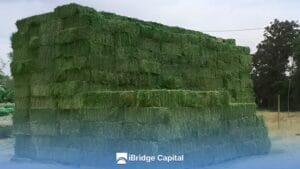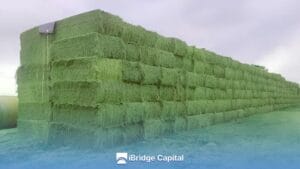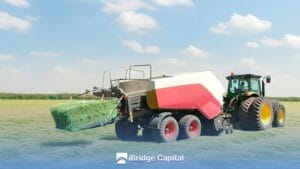Alfalfa cultivation is a cornerstone of livestock farming, and achieving productive and healthy growth is every farmer’s goal. If you’ve wondered how to optimize its growth, improve forage quality, and care for your soil at the same time, this article is for you, we’ll explore alfalfa inoculant and why it has become an essential practice.
What an alfalfa inoculant is and why it’s important
Imagine that alfalfa seeds are like tiny explorers who need a map to find food. That “map” is precisely the inoculant. It’s a biological product that contains living microorganisms, specifically beneficial bacteria of the Rhizobium meliloti genus. Their main function is to form a partnership with the plant to help it thrive.
So, what is an alfalfa inoculant really? It’s a concentrated formula of bacteria that adheres to the seeds before planting. These bacteria specialize in interacting with alfalfa roots, a natural and very beneficial process. This is part of agricultural inoculant practices, which seek to boost crops in a sustainable way.
The importance of inoculation lies in the fact that, even though soil may contain nitrogen, alfalfa plants cannot use it directly. This is where these bacteria come in.
If you’re wondering what an inoculant is for, the answer is simple: it acts as a natural fertilizer. It improves crop nutrition, promotes more vigorous growth, and increases forage production. It’s a small step in alfalfa planting and management, but one with a huge impact on the final outcome.
Understanding the function of rhizobia
The bacteria found in the inoculant, known as rhizobia in alfalfa, are the key to everything. Their scientific name is Sinorhizobium meliloti (sometimes called Rhizobium meliloti) and they have an amazing ability: they fix nitrogen from the air. This is the central function of an alfalfa inoculant. By applying the product, you ensure that the correct bacteria are available for the seed at the exact moment of germination.
A biological inoculant, like the one used for alfalfa, is based on the science of soil microbiology. These microbial inoculants adhere to the seedling’s root, forming nodules. Within these small “laboratories” that form on the roots, the bacteria capture gaseous nitrogen (N2) from the atmosphere and transform it into ammonium (NH4+), a form the plant can easily assimilate. In essence, what does an inoculant do is provide the plant with its own fertilization system. That’s why we say that the inoculant is key to a good start.
The crucial role in nitrogen fixation
Nitrogen is the most demanded nutrient by crops for their development. The role of nitrogen fixation is fundamental, especially for crops like alfalfa, which need large amounts. The bacteria what is rhizobium are the only ones capable of performing this biological function efficiently.
By using an alfalfa seed inoculant, you are not only improving the growth of your crop but also the long-term fertility of the soil. This is what distinguishes inoculants in agriculture from other practices. The root nodules not only benefit the plant but also leave residual nitrogen in the soil, which can be used by subsequent crops, such as wheat inoculant or barley inoculant.
Benefits of inoculating alfalfa seeds
Inoculating alfalfa seeds is more than just a recommendation—it’s an investment. The benefits are so tangible that they directly affect the health of the crop and the producer’s wallet. It is a practice also used for other crops such as soybean inoculant, vetch inoculant, or pea inoculant.
Using a high-quality alfalfa inoculant can make a remarkable difference in your field’s yield. Many producers ask themselves what is a legume inoculant for, and the answer is very clear: it boosts nitrogen fixation. This leads to more balanced nutrition and more robust plant development, as legumes like alfalfa depend on this symbiosis to grow.
Increasing crop yield and quality
One of the main benefits of inoculating alfalfa is the significant increase in biomass production. Studies in test fields have shown that inoculated plants have faster and more vigorous growth. Alfalfa is a forage, so its quality is just as important as its quantity. An inoculated crop tends to have a higher protein content and better digestibility for livestock.
This planting method, known as seed inoculation, is applicable to various legume species, including clover inoculant and winter legume inoculant. If you’re wondering about alfalfa inoculant benefits, the list is long:
- An increase of 20 to 40% in forage yield.
- Improvement in the nutritional quality of the alfalfa.
- Greater plant resistance to water stress.
- Development of a stronger and deeper root system.
Reducing fertilizer costs
Biological inoculants allow for a considerable reduction in the use of synthetic nitrogen fertilizers. Nitrogen is one of the most expensive nutrients in agriculture. When the inoculant’s bacteria fix nitrogen from the air, the plant obtains this nutrient for free and continuously. This is one of the great advantages of inoculants in agriculture.
The savings are significant. By using a legume inoculant, you are taking advantage of a natural and sustainable source of fertilizer, which translates into lower expenses. In some cases, the need to apply extra nitrogen during planting can be reduced or even eliminated, which directly impacts the alfalfa inoculant price. Although it has an initial cost, this is more than recovered through savings and increased production. It’s a perfect example of how a simple practice can be economically viable.
Types of inoculants available on the market
When you go to buy an inoculant, you’ll realize there are different options. Not all inoculants are the same, and knowing the types of alfalfa inoculants is key to making the best decision. The right choice depends on several factors, such as the type of planting, the equipment available, and the producer’s management style. Using a sorghum inoculant or corn inoculant is not the same as using one for alfalfa, as each crop needs a specific bacterial strain.
Liquid vs. solid inoculants
One of the main choices you’ll face is between product formats. There are two main categories: liquid alfalfa inoculant and solid inoculants.
- Liquid inoculants: They usually come in bottles or jugs and are applied directly to the seeds with sprayers. The advantage is that they are very easy to apply uniformly.
- Solid inoculants: They come in powder or peat form and are mixed with the seeds in a hopper or bag. They are effective but require more careful mixing to ensure all seeds are covered.
Understanding the differences between solid and liquid inoculant is crucial. Liquids often offer a higher concentration of bacteria, while solids may have a slightly longer shelf life if stored correctly. Some inoculants even come with protectants for the bacteria. The choice will depend on how you prefer to work and the product’s availability in your region.
How to choose the best type for your planting
Choosing the right inoculant is like choosing the right shoes for a marathon. It’s not a decision to be taken lightly. You have to consider several factors.
- Specific crop: Alfalfa needs a strain of Rhizobium meliloti. A grass inoculant or a pasture seed inoculant wouldn’t work, as these crops don’t establish this symbiosis.
- Product quality: Look for products from recognized brands. For example, the rizobacter alfalfa inoculant is one of the most reliable options in the Spanish-speaking market. The expiration date and storage conditions are vital for the product’s effectiveness.
- Type of planting: If you’re doing large-scale direct planting, a liquid inoculant may be more efficient. For smaller plantings, a solid one might work well.
- Price: The alfalfa inoculant price varies. It’s important to look for a good quality-price ratio and remember that the initial cost is more than offset by the yield benefits.
Inoculant application process
Applying the inoculant isn’t complex, but it requires following precise steps to ensure its effectiveness. Ignoring these details can compromise the success of the entire planting. The question of how to apply inoculant to alfalfa is one of the most common, and the answer is based on precision and speed. The bacteria are living organisms, and their viability is sensitive to direct sunlight and heat.
Preparing seeds for inoculation
The first step is to prepare the seeds. Make sure they are clean and dry. If you are using fungicides, check for compatibility with the inoculant. Some fungicides can be toxic to the bacteria, which would ruin the pasture inoculation.
For application, if the inoculant is liquid, mix it with a little clean water (without chlorine). If it’s solid, simply mix it with the seeds on a clean surface. The key is for every seed to be uniformly covered. You can use a hopper or a concrete mixer for large volumes, or a bag for smaller quantities. How seeds are inoculated is a simple process, but the uniformity of coverage is the most critical part.
Correct dosage and method for successful planting
The alfalfa inoculant dosage is one of the most important questions. Most manufacturers indicate the dosage on the packaging, usually one packet or bottle per 100 kg of seeds. Never use less than the recommended dosage, as this could result in deficient inoculation. If you need to know how to apply inoculant to seeds, the key is to do it just before planting. The time between inoculation and planting should not be more than 2 or 3 hours.
Planting alfalfa with inoculant should be done on a cloudy day or early in the morning when temperatures are not so high. This protects the bacteria from solar radiation and excessive heat, which can kill them. Once inoculated, the seeds must be planted immediately to ensure the highest viability of the rhizobia. Seed inoculation is a simple process, but its success depends on doing it at the right time and in the right way.
When and how to inoculate alfalfa
Timing is everything. You can’t inoculate the seeds and leave them stored for weeks. The inoculant is a perishable product and must be used soon after purchase. If you’re wondering when to inoculate alfalfa, the answer is clear: just before planting. The product’s shelf life once opened is only a few hours.
The ideal time for planting
To know how to plant alfalfa, you must consider the ideal planting date, which varies by region, but is generally in autumn or spring, when temperatures are moderate and there is enough moisture. Inoculation must be the final step before the seeds hit the soil. If you are planting in new soil, or soil that hasn’t had legumes recently, inoculation is even more critical.
It is vital to follow the manufacturer’s recommendations for the alfalfa inoculant dosage. An excess may not be harmful, but a deficit would be. The recommendation is to use the indicated dose, as it is designed to cover the seeds adequately. Remember that an inoculant for another crop, such as a pasture inoculant, will not be effective for alfalfa.
Tips for correct inoculant storage
The inoculant is a biological product, so its proper storage is vital for the bacteria to be alive and functional.
- Refrigeration: Most inoculants need to be kept refrigerated (between 4 and 8 °C). The cold chain is very important from the moment of purchase until use.
- Expiration date: Always check the expiration date. An expired product will have a low concentration of living bacteria, making the process ineffective.
- Sunlight: Avoid exposure to direct sunlight. UV rays are lethal to rhizobia.
To understand how does an alfalfa inoculant work, we must understand that they are living beings that must be in the best conditions to do their job. Good storage ensures that the product you apply is full of bacteria ready to form the symbiosis with your crop’s roots.
Common problems and solutions when inoculating
Although inoculation is a simple practice, problems can sometimes arise that compromise the result. It’s important to know what to look for and what is an inoculant in agriculture to avoid mistakes. The success of inoculation depends on a series of factors, such as product quality, application method, and environmental conditions.
What to do if inoculation fails
If after planting you notice that the alfalfa plants are not growing as expected and there are no nodules on the roots, the inoculation may have failed. The reasons can be several:
- Expired inoculant: A product that has lost viability will not work. Always check the date.
- Temperature or sunlight: Exposure to heat or direct UV light may have killed the bacteria.
- High soil acidity: Rhizobia need a neutral soil pH. Very acidic soil inhibits their growth. In these cases, the soil can be amended before planting.
- Incompatible fungicides: Some fungicides can be toxic to microorganisms.
If inoculation fails, the only option is to apply nitrogen fertilizer. This increases costs, but it’s the only way for the plant to get the nitrogen it needs. The goal is to prevent this from happening, which is why the importance of inoculation done right is so crucial.
Mistakes to avoid in the process
There are some common mistakes you can avoid to ensure the success of your planting.
- Not storing the inoculant in the cold: Keep the product in the refrigerator until you are ready to use it.
- Inoculating too far in advance: Do it just before planting. Don’t prepare the seeds the day before.
- Mixing the inoculant with chlorinated water: Chlorine kills the bacteria. Use clean, chlorine-free water.
- Not using the correct dosage: The alfalfa inoculant dosage is specified for a reason. Don’t reduce it.
- Using an inoculant for another crop: A corn inoculant or a sorghum inoculant will not work.
If you’re wondering how to make a homemade inoculant, the answer is that it’s not recommended. A commercial product guarantees the correct strain and adequate concentration of bacteria, something that is impossible to ensure at home. The success of inoculation doesn’t have to be a mystery, but a well-executed practice.
Expected results after inoculation
Inoculation is not magic; it’s science. When done correctly, the results are visible and measurable. Within a few weeks of planting, you’ll start to notice the difference in the plants’ growth. Understanding the results is key to knowing if the pasture inoculation has been successful.
Signs of successful inoculation
One of the first signs is the color of the plants. A well-inoculated alfalfa crop will have an intense, uniform green color, a sign that it is receiving optimal nutrition. If the plants have a yellowish color, it could be a sign of nitrogen deficiency, which would indicate a problem with the inoculation.
The second and most important sign is the presence of nodules on the roots. If you carefully dig up a plant about 3 to 4 weeks after planting, you should see small pink or reddish nodules on the roots. This color indicates that the rhizobia are active and fixing nitrogen. A white or greenish nodule is a sign that the bacteria are not working correctly. This is the direct result of the importance of inoculation.
Monitoring alfalfa crop growth
Continuous monitoring of your crop will help you ensure everything is going well. If the crop is growing uniformly and healthily, without yellowish spots, it is a good indication that the inoculation worked. A liquid alfalfa inoculant may be easier to monitor at the application stage, but the results on the plant are the same, regardless of whether you used a winter legume inoculant or any other type.
As your alfalfa crop grows, you’ll see it develop into a robust plant with a strong root system. This translates into greater resistance to pests and drought. At harvest, you will notice the difference in the quantity and quality of the forage. There is no better way to know if the alfalfa inoculant worked than to see the final result in your production.
Conclusion
Alfalfa inoculant is a powerful and accessible tool for improving your field’s productivity. It is not an expense but a smart investment that allows you to get more yield, improve forage quality, and care for your soil.
Knowing the types of inoculants, the correct alfalfa inoculant dosage, and the proper application method puts you on the path to success. The next time you prepare how to plant alfalfa, remember that a small step like inoculation can have a huge impact.
We invite you to consider this practice and transform the way you cultivate your forage, betting on science and sustainability. Your field and your livestock will thank you.




